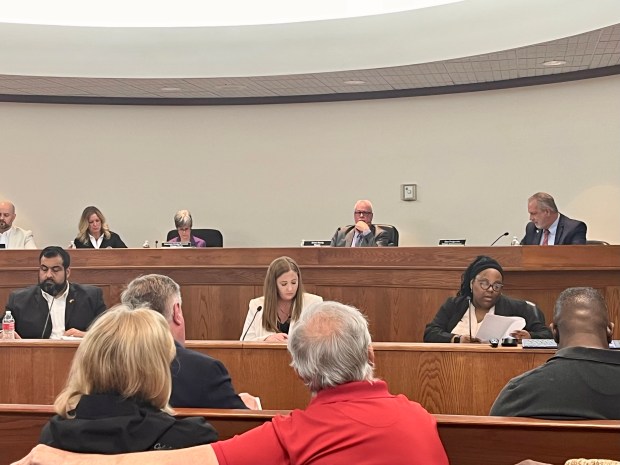QANA, Lebanon — Israeli airstrikes pounded areas across Lebanon, killing at least 21 people, officials said Wednesday, including more than a dozen in a southern town where Israeli bombardments in previous conflicts are seared into local memory.
Elsewhere in the south, a city’s mayor was among the dead in a strike that Lebanese officials said targeted a meeting coordinating relief efforts.
There was no immediate comment from the Israeli military on the strikes late Tuesday on the southern town of Qana, where 15 people were killed. Associated Press photos and video of the scene showed several flattened buildings and others with their top floors collapsed. Rescue workers carried away the remains of dead people and used a bulldozer to remove rubble, as they searched for more victims.
In 1996, Israeli artillery shelling on a United Nations compound housing hundreds of displaced people in Qana killed at least 100 civilians and wounded scores more people, including four U.N. peacekeepers. During the 2006 war, an Israeli strike on a residential building killed nearly three dozen people, a third of them children. Israel said at the time that it struck a Hezbollah rocket launcher behind the building.
“Qana always gets its share,” Mayor Mohammed Krasht told the AP, referring to the town’s grim history.
Lebanon’s caretaker prime minister, Najib Mikati, meanwhile accused Israel of “intentionally targeting” a municipal council meeting to discuss relief efforts in Nabatiyeh, where six people were killed.
“What solution can be hoped for in light of this reality?” he asked in a statement.
The Israeli military said it targeted Hezbollah command centers and weapons facilities that had been embedded in civilian areas of Nabatiyeh in Wednesday’s strikes, without providing evidence.
Israel also resumed its barrage on Beirut’s southern suburbs after a six-day pause, hitting what it said was an arms warehouse under an apartment building, without providing evidence. The military warned residents to evacuate before the strike, and there were no reports of casualties.
Israel resumes strikes on Beirut
The strikes on southern Beirut came after Mikati said the United States had given him assurances that Israel would curb its strikes on the capital.
Hezbollah has a strong presence in southern Beirut, known as the Dahiyeh, which is also a residential and commercial area home to large numbers of civilians and people unaffiliated with the militant group.
The Israeli military posted an evacuation warning on the social media platform X ahead of the strike in Beirut. An Associated Press photographer saw three airstrikes in the area, the first coming less than an hour after the notice.
In Nabatiyeh, more than half a dozen strikes hit the city and surrounding areas, according to Lebanon’s Health Ministry, which said at least six people were killed and 43 wounded, with rescue efforts still underway. The city’s mayor, Ahmad Kahil, was among those killed, provincial governor Huwaida Turk told The Associated Press.
In his statement about Nabatiyeh, Mikati, the caretaker prime minister, said the international community has been “deliberately silent” about Israeli strikes that have killed civilians.
U.N. Special Coordinator for Lebanon Jeanine Hennis-Plasschaert called reports of Kahlil’s death “alarming.”
“This attack follows other incidents in which civilians and civilian infrastructure have been targeted across Lebanon,” she said.
Hezbollah began firing rockets into Israel on Oct. 8, 2023, in solidarity with the Palestinian militant group Hamas, following the surprise Hamas attack on southern Israel that triggered the war in Gaza.
A year of low-level fighting along the Israel-Lebanon border escalated into all-out war last month, and Israel invaded Lebanon at the start of October. Israeli airstrikes have killed Hezbollah leader Hassan Nasrallah and most of his senior commanders, and Israel has vowed to continue its offensive until its citizens can safely return to communities near the border.
Some 2,300 people have been killed by Israeli strikes in Lebanon since last October, more than three-quarters of them in the past month, according to Lebanon’s Health Ministry. The fighting has displaced some 1.2 million people in Lebanon.
Hezbollah’s rocket attacks, which have extended their range and grown more intense over the past month, have driven around 60,000 Israelis from their homes in the north. The attacks have killed nearly 60 people in Israel, around half of them soldiers.
Hezbollah has said it will keep up its attacks until there is a cease-fire in Gaza, but that appears increasingly remote after months of negotiations brokered by the United States, Egypt and Qatar sputtered to a halt.
Palestinians say 350 bodies recovered from Israeli operation in Gaza
Israel is still at war in Gaza more than a year after Hamas’ attack, in which some 1,200 people were killed, mostly civilians, and another 250 were abducted. Around 100 captives are still being held, about a third of whom are believed to be dead.
Israel has been carrying out a major operation for more than a week in Jabaliya, an urban refugee camp in the territory’s north dating back to the 1948 war surrounding Israel’s creation. Israeli forces have repeatedly returned to Jabaliya and other areas after saying that Hamas militants had regrouped.
Hospitals have received around 350 bodies since the offensive began on Oct. 6, according to Dr. Mounir al-Boursh, the director-general of Gaza’s Health Ministry.
He told the AP that more than half the dead were women and children, and that many bodies remain in the streets and under the rubble, with rescue teams unable to reach them because of Israeli strikes. “Entire families have disappeared,” he said.
Israel’s offensive has killed over 42,000 people, according to the Health Ministry, which does not say how many were fighters but says more than half were women and children. The offensive has left large areas in ruins and displaced around 90% of Gaza’s population of 2.3 million people, forcing hundreds of thousands into crowded tent camps or schools-turned-shelters.



